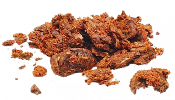 Propolis – bee glue, resin (Greek, pro – before, polis – city, fortress) is an organic compound containing resinous substances, ash component, and volatile ethers. Propolis ranks second after honey concerning its medical significance and effectiveness, popularity and availability. It has a positive effect in the treatment of many diseases. Neither honey nor propolis can be considered a panacea for treatment of all diseases and a universal remedy. Treatment with propolis should be carried out under the supervision of a doctor in strict accordance with the indications and contraindications for each patient.
Propolis – bee glue, resin (Greek, pro – before, polis – city, fortress) is an organic compound containing resinous substances, ash component, and volatile ethers. Propolis ranks second after honey concerning its medical significance and effectiveness, popularity and availability. It has a positive effect in the treatment of many diseases. Neither honey nor propolis can be considered a panacea for treatment of all diseases and a universal remedy. Treatment with propolis should be carried out under the supervision of a doctor in strict accordance with the indications and contraindications for each patient.
The basis of propolis is resinous substances that bees collect from buds, young shoots of trees, young shrubs and flower buds.Another part of propolis is a burping of a bee when it digests the pollen of plants. In the stomach of a bee, the pollen grains swell and burst. The liquid portion is used by the bee to feed the brood, the shell of the pollen grains containing balsams is regurgitated and mixed with the secretion of mandibular and pharyngeal glands and wax and then used as propolis. Propolis, obtained by a bee during the processing of pollen, is called “true propolis”; it is softer, malleable, contains less wax and other impurities.
Bees use propolis to cover the walls of the hives and frames, to varnish comb cells, to narrow the size of the hive entrance in the cold season and to immure the corpses of rodents that have managed to get into the hive. Natural honeycombs contain 5-10% of balsamic propolis. Thanks to the propolis, an almost sterile atmosphere is maintained in the hive and the development of germs and fungi is prevented. To create such a favorable microbiological climate only 20-30 g of propolis is required in the hive.
External sources of propolis are poplar, birch, aspen, willow, elm, conifers, sunflower, flower buds, and unripe fruits. The bee lays the collected propolis into the leg baskets also used for the pollen collection, delivers it to the hive and passes it on to the builder bees. Most of the propolis is collected in the period of growing the brood. In the absence of brood the accumulation of propolis in the hive stops. The beekeeper collects propolis by scraping the walls and frames of the hive and from upper canvases. 20-30 g of propolis can be collected from a hive at one time. During the summer season up to 200-300 g can be collected from a hive.
Over time, propolis is oxidizing and losing its aromatic substances due to evaporation. For storage propolis is rolled into bars of 20-50-100 g, wrapped in two layers of wax paper and kept in a cool place in the refrigerator. Such propolis does not lose its healing properties for up to 5 or even 10 years.
